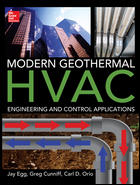Through incentive funding provided by the Port of San Francisco, the pier's entire climate control system was redesigned for commercial and public use by Rehau, Inc. and the San Francisco engineering firm, Flack & Kurtz. The renovated pier opened in December 2000.
A FORGOTTEN TREASURE
The pier and its warehouse were originally constructed in the 1930s, and used as a sugar terminal, where ships unloaded cargo for storage and distribution to a nearby railroad. Recently, however, the pier was being used as a car park, and despite its waterfront location, no renovations were planned because it was too close to the Embarcadero Freeway, says the manufacturer. After the freeway collapsed during the 1989 earthquake, the Port of San Francisco initiated plans to revitalize Pier One by converting it to office space.THE CONCRETE CHALLENGE
According to Rehau, the Pier One warehouse was never designed to be heated or cooled. The challenge for the manufacturer and Flack & Kurtz was to overcome a lack of insulation in the structure, which has exterior walls of 4-in. solid concrete. Although concrete provides thermal mass (it heats up and cools down slowly), it does not provide good insulation, says the manufacturer. During the winter, outside temperatures gradually cool the walls, which then radiate cold into the building.To maintain the historic integrity of the warehouse, funding requirements developed by the California State Historic Preservation Office, in cooperation with the Port of San Francisco, specified that no insulation be installed on the exterior walls. Those associations wanted a system that would not obstruct the exposed beams and rafters of the building or the "clear story" at the roof peak, because those features lend important personality to the interior space, said the manufacturer. It was decided that the beams should not be obstructed with hvac ductwork. According to Flack & Kurtz associate Allan Montpelier, "A radiant floor system minimally impacts the aesthetic quality of the office space while providing optimal comfort and energy efficiency by using the RFH system to both heat and cool the building."
THE COMPANY FOR THE JOB
A radiant floor heating and cooling system was chosen to maintain the architectural integrity of the structure. Rehau's RAUPEX® 02 Barrier cross-linked polyethylene (PEX-a) pipe was selected for its durability and for its simplicity of installation, according to the manufacturer. The company says the pipe is strong, reliable, lightweight, and flexible. In the Pier One warehouse, 132,000 ft of 3/4-in. pipe was installed 10 in., on-center, in approximately 250-ft circuit-lengths. The circuits were placed on an existing concrete slab over a layer of insulating bubble foil, to keep direct heat or cold up through the carpeted floor, says the manufacturer.The pipe circuits connect to 68 of the manufacturer’s PRO-BALANCE™ manifolds with gauges, optimizing flow rates and temperature mixing of the system's heat transfer fluid, says the manufacturer.
The two floors of the finished warehouse provide about 160,000 sq ft of office space. The manufacturer says perimeter and interior zones are individually controlled to allow adjustments in areas with different heating requirements. A direct digital control system anticipates building use and activates heating or cooling a few hours in advance, saving energy by tempering the concrete thermal mass, in accordance with anticipated heating/cooling demands, Rehau says.
A SOLUTION
Radiant systems have traditionally been used for heating, by circulating a heated fluid through pipes placed within floor structures but while designing the Pier One system, but engineers realized that the system could also be used for cooling, says the manufacturer. Rehau says when activated, a dedicated chiller cools the heat transfer fluid, lowering the temperature of the thermal mass, which in turn lowers the mean radiant temperature (MRT) of the building. For the Pier One project, the architects said they designed an environmentally friendly subsystem that safely cools the hot components of the chiller though a closed-loop circuit of RAUPEX pipe. A life-cycle cost-analysis (LCCA) by Flack & Kurtz expects an energy savings of 15% over 10 years, compared with a standard hvac system, says the manufacturer. Although base building construction costs were higher for the radiant system, tenant improvement costs (the costs to fit out the building shell for tenants) were lower because the system does not require the extensive ductwork of an hvac system. After installation, the LCCA showed lower operating costs and a lower impact on usable building area, the manufacturer says.Publication date: 11/05/2001





